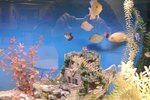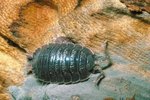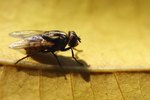
Several aquatic insect varieties burrow in mud and sand during their larval and nymph stages. Burrowing provides protection from predation and ensures moisture is available in low water conditions. Burrowing insects are common in warm and cold freshwater environments. The insects typically leave the burrow during emergence cycles that lead to the adult phase of the life cycle.
Diptera
Diptera are commonly referred to as midges or gnats. The insects are often mistaken for the mosquito, but they do not bite. Diptera are common and present throughout North America. The insect has a complete metamorphosis life cycle that includes the egg, larva, pupa and adult forms. The larval phase of this life cycle frequently burrows in sand and mud. Scoop sand or mud from a stream or lake using a kitchen seine and dump the sediment in clear water. As it separates you will find an abundance of freed larvae.
Trichoptera
Trichoptera is an order of aquatic insects common in freshwater environments in North America. The insect is commonly referred to as a caddisfly. The caddisfly is an aquatic moth with a complete metamorphosis life cycle. Caddisflies utilize gravel and plant fibers to build cocoons. Several common varieties of caddisflies exist with free-roaming, burrowing, net building and cased forms. Burrowing varieties are especially common in the northwest region of the United States
Ephemeroptera
Order Ephemeroptera insects are commonly called mayflies. Numerous mayfly varieties exist around the world. The mayfly endures an incomplete metamorphosis life cycle. This means the insect lives through the egg, nymph and adult phases. Mayfly nymphs are divided into crawlers, swimmers and burrowers. The burrowers live in sand and mud where they feed off microscopical food particles present in sediment. Burrowers typically have large gills, which are used to fan the sediment for oxygen pockets. The Hexagenia (large yellow mayfly) is a common form of burrowing mayfly.
Megaloptera
The Megaloptera order includes the common named alderfly and dobsonfly. At rest, the adult form looks similar to a caddisfly with the tent-shaped wings. The insect has four wings, which are visible in flight. It also has an obvious mandible designed to chew plant materials. Megaloptera endure a complete metamorphosis life cycle. The larval phase burrows in mud and sand. Eventually, the larva crawls to land where it pupates into the adult phase.
References
Photo Credits
-
Hemera Technologies/PhotoObjects.net/Getty Images
Writer Bio
Zach Lazzari is a Montana based freelance outdoor writer and photographer. You can follow his work at bustedoarlock.com.




